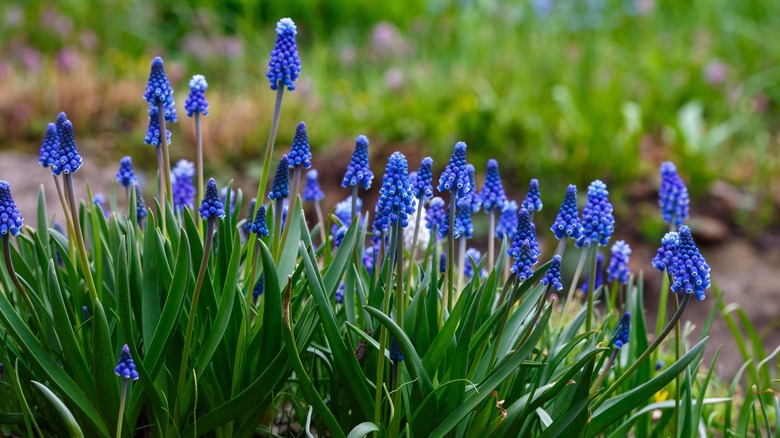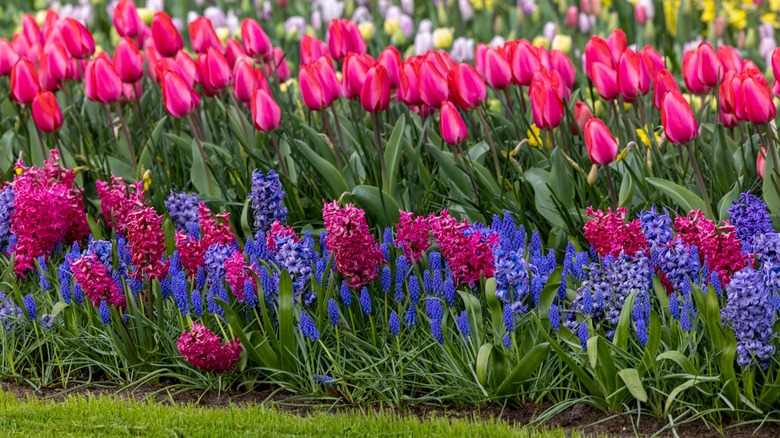Flower Bulbs To Plant Alongside Muscari In The Fall
Muscari botryoides, also known as grape hyacinths, are spring-blooming bulbs that produce small stalks bearing clumps of bright violet-blue flowers that somewhat resemble clusters of grapes. They come in a variety of blue hues, including pale blues and bi-colors, as well as white and pale pink. The foliage emerges in early spring, followed by the flowers that bloom for several weeks. Grape hyacinths provide brilliant color, and look gorgeous when planted with early spring flowering bulbs such as daffodils, crocuses, Dutch hyacinths, and early-blooming tulips.
These bulbs tend to multiply each year, and in most garden settings they will spread gradually outward from their original planted area. In some parts of the United States, they are considered invasive. They're on the invasive species list in West Virginia and are listed as invasive or noxious weeds in some parts of the Northeast, including southern Pennsylvania, New Jersey, and Massachusetts, and the Midwest. For most gardeners, these bulbs should be fairly easy to manage and keep from spreading to unwanted areas. It's advisable to not plant them in untended areas such as woodlands or meadows.
Choosing bulbs to plant alongside Muscari can depend on your growing conditions and color preferences. Most spring-blooming bulbs thrive best in loamy, well-draining soil (to help prevent bulbs from rotting). To improve soil nutrients and texture, add some compost and other soil conditioners such as aged manure, used coffee grounds, wood ash, or peat moss. Be sure to plant bulbs in the fall at the proper planting time for your growing zone.
Colorful bulbs that complement Muscari
If you have the traditional cobalt or violet-blue shades of Muscari, this is a very flexible color to blend others with. Yellows and oranges go very well with bright blue and violet shades in spring, so planting colorful daffodils such as 'Fortune,' 'Scarlett O'Hara,' 'Fortissimo,' or 'Jetfire' with bright blue Muscari like 'Ocean Magic' or 'Blue Magic.' For early-flowering tulips, try planting Emperor tulips which come in shades of orange and yellow, as well as red, pink, and white.
Some gardeners like to design specific spring color palettes, such as blue and white. Since Muscari species come in shades of dark, medium, or pale blue, and white, they look wonderful planted with all-white daffodils such as 'Mount Hood' or 'Thalia.' Blue Dutch hyacinths include 'Delft Blue' and 'Blue Jacket,' or try white ones such as 'Aiolos.' When planting Dutch hyacinths, make sure they're planted slightly deeper than Muscari: 3 to 4 inches for Muscari and 5 to 6 inches for Dutch hyacinths. Daffodils should be planted 7 to 8 inches deep.
Another design method is to plant a cool color palette with companion flowering bulbs in shades of pink and purple, including hot pink, lavender, or royal purple. Pink and purple Dutch hyacinths include 'Fondant,' 'Pink Pearl,' 'Purple Pride,' 'Woodstock,' or 'Purple Sensation.' Deeper colors look great with pale blue grape hyacinths (like 'Valerie Finnis' or 'Manon'), while pastel pinks and purples look lovely with darker blue grape hyacinths, but you can experiment to see what looks best for your garden. Early-flowering tulips in cool colors include 'Foxtrot,' 'Purple Prince,' 'Candy Prince,' or 'Van der Neer.'

